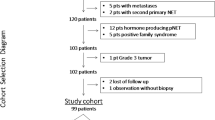Abstract
Background
Sporadic malignant non-functioning pancreatic endocrine tumors (NF-PETs) are an important subset of pancreatic neoplasms. The aim of this study was to assess the impact of improved imaging on these features in a tertiary referral centre within a 20-year follow-up.
Patients and methods
From 1988 to 2009, 51 patients were treated for sporadic malignant NF-PETs. Forty-one patients who underwent tumor resection were retrospectively attributed according to the date of the initial diagnosis, group 1: 1988–1999 vs. group 2: 2000–2009.
Results
Cross-sectional imaging led to positive prediction of NF-PETs in all patients. Curative resection was achieved in 76%. Synchronous metastases were present in 56% with a positive prediction of 43%. In group 1, the mean reported CT-determined tumor size was 56 vs. 54 mm in group 2 (p = 0.89). Synchronous metastases were present in 61% in group 1 vs. 57% (p = 0.99) in group 2. Metachronous metastases were recorded in 39% in group 1 vs. 43% (p = 0.84) in group 2. The mean interval from initial resection to diagnosis of metastatic disease was significantly shorter (p = 0.01) in patients from group 1 (14 vs. 61 months). Cumulative 5- and 10-year survival rates were 77% and 72% in group 1 vs. a 5-year survival rate of 66% in group 2.
Conclusion
So far, improved CT-based imaging has no impact on earlier detection of initial synchronous metastases in sporadic malignant NF-PETs, while metachronous metastases are detected earlier.
Similar content being viewed by others
References
Öberg K, Eriksson B (2005) Endocrine tumors of the pancreas. Best Pract Res Clin Gastroenterol 19:753–781
Akerstrom G, Hessman O, Hellman P et al (2005) Pancreatic tumors as part of the MEN-1 syndrome. Best Pract Res Clin Gastroenterol 19:819–830
Solcia E, Kloeppel G, Sobin LH (2000) World Health Organization: international histological classification of tumours: histological typing of endocrine rumours. Springer, Berlin
Touzios JG, Kiely JM, Pitt SC et al (2005) Neuroendocrine hepatic metastases: does aggressive management improve survival? Ann Surg 241:776–785
Cadiot G, Vuagnat A, Doukhan I et al (1999) Prognostic factors in patients with Zollinger- Ellison syndrome and multiple endocrine neoplasia type 1. Groupe d’Etude des Neoplasies Endocriniennes Multiples GENEM and groupe de Recherche et d’Etude du Syndrome de Zollinger-Ellison (GRESZE). Gastroenterology 116:286–293
Yu F, Venzon DJ, Serrano J et al (1999) Prospective study of the clinical course, prognostic factors, causes of death, and survival in patients with long-standing Zollinger-Ellison syndrome. J Clin Oncol 17:615–630
Sarmiento JM, Que FG, Grant CS et al (2002) Concurrent resections of pancreatic islet cell cancers with synchronous hepatic metastases: outcomes of an aggressive approach. Surgery 132:976–983
Fendrich V, Waldmann J, Bartsch DK, Langer P (2009) Surgical management of pancreatic endocrine tumors. Nat Rev Clin Oncol 6:419–428
Panzuto F, Nasoni S, Falconi M et al (2005) Prognostic factors and survival in endocrine tumor patients: comparison between gastrointestinal and pancreatic localization. Endocr-Relat Cancer 12:1083–1092
Bettini R, Boninsegna L, Mantovani W et al (2008) Prognostic factors at diagnosis and value of WHO classification in a mono- institutional series of 180 non-functioning pancreatic endocrine tumors. Ann Oncol 19:903–908
Sofuni A, Iijima H, Moriyasu F et al (2005) Differential diagnosis of pancreatic tumors using ultrasound contrast imaging. J Gastroeneterology 40(5):518–525
Papanikalaou IS, Adler A, Neumann U, Neuhaus P, Rösch T (2009) Endoscopic ultrasound in pancreatic disease—its influence on surgical decision-making. An update 2008. Pancreatology 9(1–2):55–65
Seemann MD, Meisterschlaeger G, Gaa J, Rummeny EJ (2008) Assessment of the extent of metastasis of gastrointestinal carcinoid tumors using whole body PET, CT, MRI, PET/CT and PET/MRI. Eur J Med Res 11(2):58–65
Krausz Y, Keidar Z, Kogan I et al (2003) SPECT/CT hybride imaging with 111- in- pentetreotide in assessment of neuroendocrine tumors. Clin Endocrinol 59:565–573
Bartsch DK, Schilling T, Ramaswamy A (2000) Management of nonfunctioning islet cell carcinomas. World J Surg 24(11):1418–1424
Rindi G, Klöppel G, Alhman H et al (2006) TNM staging of foregut (neuro) endocrine tumors: a consensus proposal including a grading system. Virchows Arch 449:395–401
Liu Y, Song Q, Jin HT et al (2009) The value of multidetector-row CT in the preoperative detection of pancreatic insulinomas. La Radiologica Medica 114(8):1232–1238
Norton JA, Kivlen M, Li M et al (2003) Morbidity and mortality of aggressive resection in patients with advanced neuroendocrine tumors. Arch Surg 138:859–866
Mörk H, Ignee A, Schuessler G (2007) Analysis of neuroendocrine tumor metastasis in the liver using contrast enhanced ultrasonogaphy. Scand J Gastroenterol 42(5):652–662
Fendrich V, Langer P, Celik I et al (2006) An aggressive surgical approach leads to long-term survival in patients with pancreatic endocrine tumors. Ann Surg 244(6):845–851
Rockall AG, Reznek RH (2007) Imaging of neuroendocrine tumors (CT/MR/US). Best Pract Res Clin Endocrinol Metab 21(1):43–68
Capurso G, Falconi M, Panzuto F et al (2009) Risk factors for sporadic pancreatic endocrine tumors: a case–control study for prospectively evaluated patients. Am J Gastroenterol 1004(12):3034–3041
Conflicts of interest
None.
Author information
Authors and Affiliations
Corresponding author
Additional information
Katja Maschuw and Volker Fendrich contributed equally to this work.
Rights and permissions
About this article
Cite this article
Maschuw, K., Fendrich, V., Langer, P. et al. Impact of CT-based diagnostic imaging on management and outcome of nonfunctioning pancreatic tumors. Langenbecks Arch Surg 396, 1181–1186 (2011). https://doi.org/10.1007/s00423-011-0748-0
Received:
Accepted:
Published:
Issue Date:
DOI: https://doi.org/10.1007/s00423-011-0748-0




